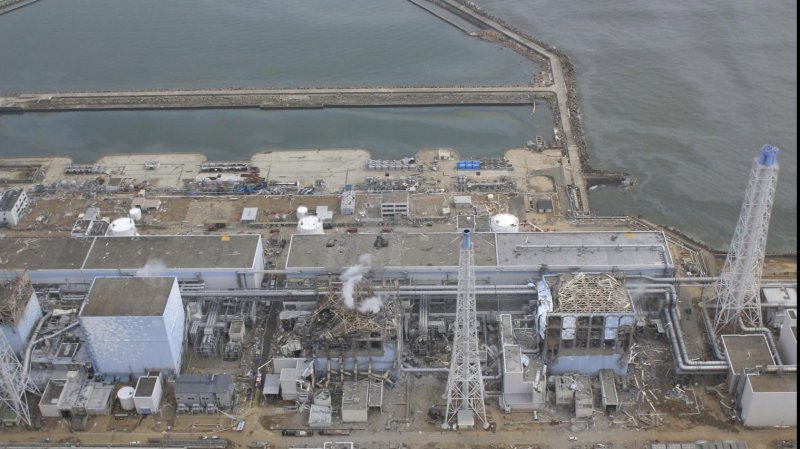The crippled Fukushima Dai-ichi nuclear power plant is seen in Okumamachi, Fukushima prefecture, northern Japan in this March 20, 2011 aerial photo taken by a small unmanned drone and released by AIR PHOTO SERVICE. From left: Unit 1, partially seen; Unit 2, Unit 3 and Unit 4. UPI/Air Photo Service Co. Ltd. |
License Photo
TOKYO, Aug. 20 (UPI) -- Highly radioactive water has leaking from a storage tank at Japan's crippled Fukushima nuclear power plant is the worst since the March 2011 earthquake and tsunami, says Tokyo Electric Power Co., the plant's operator.
Japan's Nuclear Regulation Authority Monday provisionally classified the leak as a "level 1" incident, the lowest on the eight-point International Nuclear and Radiological Event Scale, the Asahi Shimbun newspaper reported.
It is the first time the regulator has declared a radiological release incident at the facility since the 2011 disaster and comes amid increasing concerns about Tepco's failure to stop the flow of contaminated water from the plant.
"We may have to check out other tanks for more leaks, though the extent depends on why the leak occurred," said Hideka Morimoto, the Nuclear Regulation Authority's deputy secretary-general told reporters Tuesday, The Wall Street Journal reports.
Approximately 1,000 storage tanks at the stricken facility are being used to store the excess water being pumped out of the radioactive reactor and turbine buildings.
The Journal reported 79,000 gallons of the radioactive water had leaked from the tank in the latest incident.
Tepco told a press conference Tuesday a puddle that formed near the tank where the leak occurred was emitting a radiation dose of 100 millisieverts an hour, which is about 350,000 times higher than natural background levels, the Financial Times reports.
Earlier this month the Japanese government announced about 300 tons of groundwater containing radioactive waste could be flowing daily from the crippled nuclear complex into the adjacent Pacific Ocean.
"We must prevent the contaminated water from dispersing further due to rain and [we] are piling up more sandbags," Masayuki Ono, a spokesman for Tepco was quoted as saying by The New York Times.
Much of that contaminated water has already been absorbed into the soil, Ono said, and workers would need to remove some of the soil with mechanic shovels and other heavy machinery.
"It is going to be very difficult and dangerous for Tepco to keep on storing all this water," Hiroshi Miyano, an expert in nuclear system design at Hosei University in Tokyo, told The New York Times, noting another strong earthquake or tsunami could destroy the tanks and lead to a huge spill.
Miyano told the Times eventually Tepco will have no choice but to start releasing some of the water into the ocean after cleaning it.















